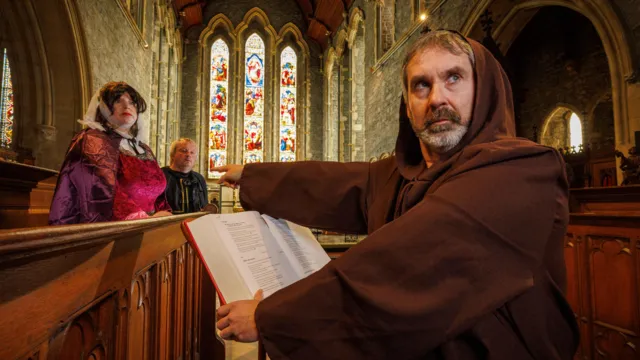Think of the witch trials and you probably conjure an image of the 16th or 17th Century in Scotland, central Europe or colonial America.
But this week, one town is remembering the woman believed to have been the first in Ireland to be executed for witchcraft 700 years ago.
Kilkenny will host historians and archaeologists, run a service of atonement and an oral history project, and make sure every school gets an educational resource pack about the events of 1324.
It is all to remember the “utter miscarriage of justice” and try to “make amends” – so says the dean of the cathedral where the service of atonement will take place.
Without guilt, but without influence’
Petronella de Meath was a maidservant to a wealthy woman in Kilkenny when it was a young and small bustling Norman town.
She had the poor fortune to get caught up in events when accusing fingers were pointed at her boss, Alice Kyteler.
After Kyteler’s four husbands died one after the other, she was accused of using witchcraft to poison them, and de Meath was accused of being one of her co-conspirators.
It is thought she confessed after being subjected to torture.
Witchcraft had been treated as a misdemeanour up until shortly before this point.
But when Pope John XXII published a Papal Bull denouncing it as heresy this opened the door to much more severe punishment.
Although both women were found guilty of witchcraft, Kyteler fled and only de Meath was burnt at the stake, on 3 November 1324.
Kyteler was a wealthy moneylender and had even lent money to the English king, but de Meath had no such friends in high places.
Very little is known about her.
Historians do not know what age she was when she died, or what she looked like.
“She was a servant girl from Meath which is not far away,” Dean Stephen Farrell of St Canice’s Cathedral, Kilkenny, told BBC News NI.
“But 700 years ago she was far from home. She didn’t have powerful relatives protecting her. She was without guilt, but without influence.
“How do we make amends?
“What happened to her was an utter miscarriage of justice. It is indefensible. It is the abuse of power.”
Some of the Kyteler family are buried in the cathedral, as is Bishop Richard LeDrede who led the charge against the accused women.
But de Meath had no tomb or memorial – and so, the idea of an atonement service began to take shape.
Template for what happened after’
“It’s not righting a wrong,” said Kilkenny County Council’s heritage officer Regina Fitzpatrick, who has been organising these commemorative events for the past year.
“But it’s casting a light on something that was wrong. In terms of women’s history, it’s a really important story.”
It’s a history that may seem long gone, but the trial and its outcome set a precedent that became central to the witch hunts several hundred years later, when about 50,000 people were executed for witchcraft, 80% of them women.
It was the “template for what happened after”, Ms Fitzpatrick said.
Kilkenny is not the only place reckoning with its past when it comes to historical witch trials. In 2022, then-First Minister Nicola Sturgeon issued a formal apology to people accused of witchcraft in Scotland, and in Connecticut, USA, 12 people were exonerated last year.
But in Kilkenny, organisers did not know who it would be appropriate to ask for an apology. The Pope? King Charles? Instead they chose to have a joint civic service.
Kilkenny’s mayor will speak, and the night before, invited guests will gather for dinner in the cathedral for a dinner that Dean Farrell suggests may act as a “dignified send-off that one suspects she was denied 700 years ago”.
For Dean Farrell, the story also serves as a cautionary tale for Christians today.
“How do we not be glib about this?” he asks.
“There’s always a danger we look back on this and say, thank God we are not like them. We are wonderfully enlightened and better.
“What are our blind spots today? What acts of injustice do we tolerate in our midst?
“What will people in 700 years time look back at us and say, goodness, how on Earth was this not in their consciousness?”








